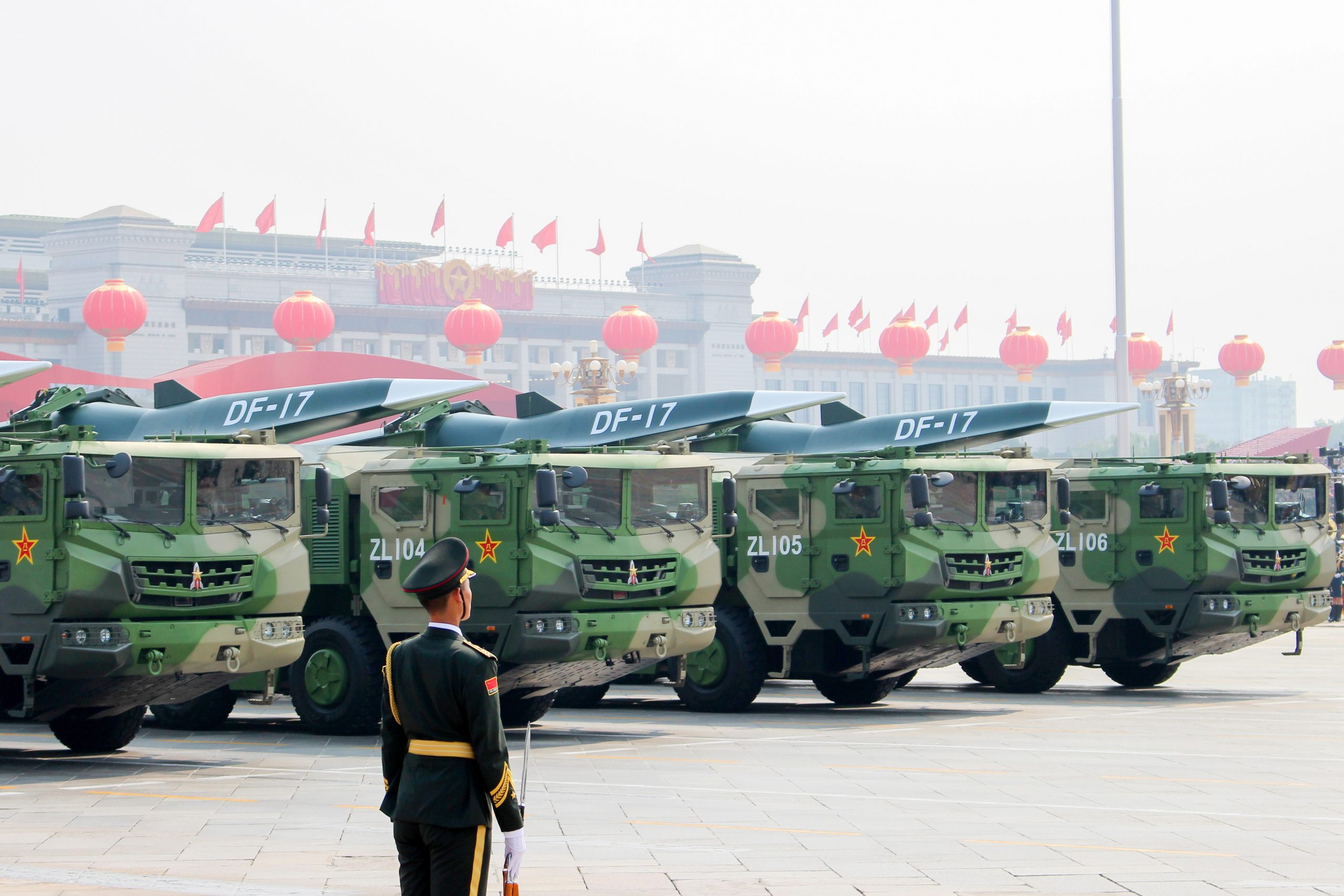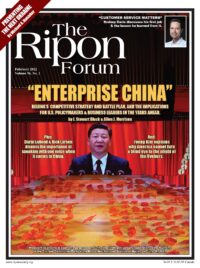
Last October, the Financial Times reported that the Chinese military tested a nuclear-capable hypersonic glide vehicle in August 2021. While this missile may have missed its target by up to two-dozen miles, it successfully traversed low-Earth orbit before descending through the atmosphere, confirming fears that the United States has fallen behind China in the hypersonic arms race and potentially in other facets of military modernization. In particular, Beijing’s willingness to test its weapons even when the probability of success is lower, compared to Washington’s more risk-averse approach to testing weapons only when it is much more confident in success, is yielding results. General Mark Milley, chairman of the U.S. Joint Chiefs of Staff, even declared this test “very close” to a Sputnik moment in the broader strategic and technological competition with China.
While this development is concerning, Chinese advances in hypersonic weapons — as well as other emerging military and dual-use technologies — do not constitute a Sputnik moment by themselves. Rather, the combination of these technologies, and the speed with which China is harnessing them to modernize its forces and capabilities in new and unanticipated ways, pose the greatest threat to U.S. and allied security. There is an ongoing revolution in military affairs, and if China is the first to redefine the way that great powers fight and deter wars, there could be perilous geopolitical implications. To better compete with Chinese military modernization, the United States must structurally adapt its approach to investing in the right capabilities, acquiring defense-relevant technologies, and leveraging diplomacy in creative ways.
There is an ongoing revolution in military affairs, and if China is the first to redefine the way that great powers fight and deter wars, there could be perilous geopolitical implications.
Hypersonic weapons must be understood within this broader technological context. These new missiles are certainly ground-breaking, since they combine the speed of intercontinental ballistic missiles (ICBMs) with the maneuverability and low flight profile of cruise missiles to significantly complicate (and potentially circumvent) early warning systems and current missile defense capabilities. By themselves, however, they do not meaningfully affect the nuclear balance of power between China and the United States. If deployed en masse, traditional Chinese (and Russian) ICBMs have long been capable of overwhelming U.S. missile defenses, and this capability is only growing as China continues to expand the size of its nuclear arsenal through the construction of missile silo fields. The threat of mutual assured destruction is still the predominant nuclear deterrence paradigm and is not disrupted by hypersonic weapons alone.
However, Chinese hypersonic weapons become far more concerning if they are integrated with other emerging capabilities. Like the United States and Russia, China is seeking to leverage an ongoing revolution in strategic forces that threatens to undermine the long-standing, traditional models of nuclear deterrence, and the classic U.S. nuclear triad may be put at risk in the future. In particular, Chinese quantum radars and advanced air defense systems may be increasingly capable of detecting and targeting the United States’ stealthy and non-stealthy nuclear-armed bombers; China is actively working to improve its anti-submarine warfare capabilities, which may threaten the long-term survival of U.S. nuclear-armed submarines, which were long thought to be invulnerable; and advances in Chinese missile defense systems such as the HQ-19, S-300, and S-400 will enable the interception of short-, medium-, and intercontinental-range ballistic missiles. At the same time, hypersonic weapons can target missile sites and delivery mechanisms before they are launched, thereby threatening to undermine the survivability of U.S. ICBMs, submarine-launched ballistic missiles (SLBMs), and the Long Range Stand Off Weapon (LRSO). Together — if deployed alongside China’s growing and increasingly sophisticated nuclear arsenal and its cyber, counterspace, electronic warfare, and directed energy capabilities which threaten the United States’ early warning system and nuclear command, control, and communications (NC3) architecture — these emerging technologies may eventually enable a devastating first-strike capability against the U.S. homeland. Fortunately, the United States maintains a capable and ready nuclear arsenal and has made comparable gains in strategic forces, especially in missile defense, but the global strategic forces balance no longer so clearly favors the United States. Moreover, because of rapidly changing technologies being incorporated into forces on both sides, that balance is highly dynamic and could even become fragile if sufficient uncertainties emerge attendant to nuclear and crisis stability.
Beyond strategic forces, Chinese military modernization may reshape the operational conduct of warfare on the future battlefield. Chinese planners have studied the classic American way of war, as demonstrated by victories like the 1990-1991 Gulf War, and have accordingly oriented their modernization programs toward preventing the United States from projecting and amassing combat power and from deploying it via sophisticated platforms. In particular, this has meant a focus on speed and mass. Regarding speed, conventionally-armed hypersonic weapons and a wide range of other uncrewed systems will allow China to more quickly overwhelm U.S. bases, aircraft carriers, and other means of power projection, while China’s investments in artificial intelligence, cloud computing, and data analytics will enable faster and more agile command and control in accordance with its vision of “Intelligentized” warfare. Regarding mass, China can better leverage firepower within the region through its ambitious shipbuilding program, a variety of anti-ship missiles and munitions, and advances in autonomous systems and drone swarms.
When combined, these strategic and operational capabilities spell trouble for U.S. forces, particularly in light of competing global commitments. These capabilities threaten to undermine the very sources of U.S. military power, including the United States’ nuclear triad, ability to project large-scale conventional capabilities, and global defense posture including a vast network of bases hosted by allies and partners. As numerous wargames have pointed out, if geopolitical tensions were to escalate over a crisis — such as ramped-up Chinese coercion of Taiwan or another flashpoint in the Indo-Pacific — and cause a U.S.-Chinese war, the United States could very well lose due to modernized Chinese forces. Careful consideration is necessary to confront these challenges, and the following three recommendations embody high-priority initial steps for U.S. defense policymakers.
To better compete with Chinese military modernization, the United States must structurally adapt its approach to investing in the right capabilities, acquiring defense-relevant technologies, and leveraging diplomacy in creative ways.
First, policymakers need to articulate the right priorities for modernizing U.S. defense technology. If the future of warfare will be increasingly “networked, data-driven, faster, and contested from longer ranges and across all domains,” as argued by the Atlantic Council’s report on Seizing the Advantage: A Vision for the Next U.S. National Defense Strategy, the United States needs enhanced intelligence, surveillance, and reconnaissance (ISR) capabilities and data aggregation tools to understand that environment; a Joint All-Domain Command and Control (JADC2) system to share information and issue orders; and an increasingly diverse range of kinetic and non-kinetic fires like hypersonic weapons to strike adversaries in different ways regardless of the environment. It will also need to modernize its nuclear arsenal and adopt new technologies into strategic forces in a way that stays ahead of and hedges against adversaries’ potential technological threats. These priorities will allow the United States to compete with Chinese strategic forces and operational speed and mass, thereby fielding a more effective nuclear and conventional deterrent.
Second, Pentagon planners need to adapt their weapons acquisition mindset. The United States maintains a world-leading innovation and industrial base that is capable of efficaciously and efficiently producing new technologies, but policymakers are often oriented on the wrong capabilities. Rather than “compete by differentiation” — and continue the longstanding focus on expensive and sophisticated platforms —the United States should “compete by cost” instead. This means developing advanced network-driven capabilities, investing in more numerous, cheaper, and attritable systems like drone swarms, and partnering in new ways with the innovative firms that are producing them. The more rapid acquisition of cheaper, networked capabilities will enable much more effective competition with China’s Military-Civil Fusion strategy.
Lastly, while arms control with China in the near term appears unlikely, diplomacy will be a key tool for mitigating tensions and providing a new, stable platform for the strategic forces balance of the 2030s. There will be opportunities for articulating clear redlines, pursuing offramps during escalated tensions, and even curtailing certain weapon development programs if they are mutually expensive or unattractive. Diplomats must be vigilant for such opportunities as they arise.
No single Chinese technology will be a game changer; rather, Chinese military modernization should be evaluated holistically for the key capabilities being produced. If the United States is to compete effectively, it needs to better understand the way that China is integrating its emerging capabilities to seek to change future combat outcomes and deterrence, while modernizing its own forces and adjusting its diplomatic approaches to prepare for that future.
Barry Pavel is senior vice president and director of the Scowcroft Center for Strategy and Security at the Atlantic Council. Christian Trotti is assistant director of the Forward Defense practice at the Atlantic Council’s Scowcroft Center for Strategy and Security.




